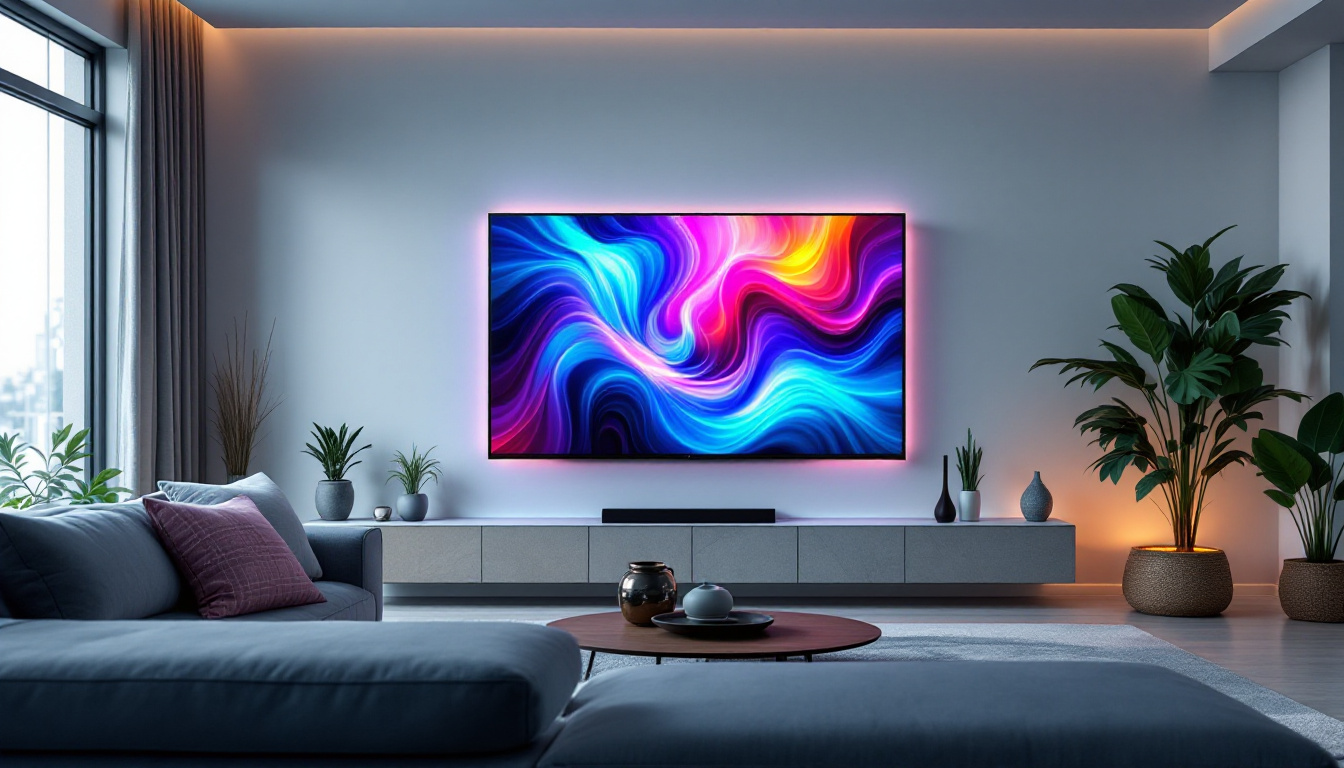In the world of display technology, the debate between LCD (Liquid Crystal Display) and LED (Light Emitting Diode) continues to captivate consumers and tech enthusiasts alike. Both technologies have their own unique advantages and disadvantages, making it essential to understand their differences before making a purchase. This article delves into the intricacies of LCD and LED displays, ultimately helping you decide which is better suited for your needs.
Understanding LCD Technology
LCD technology has been a staple in the realm of television and computer screens for many years. Utilizing liquid crystals sandwiched between two layers of glass, LCDs manipulate light to create images. This technology is renowned for its ability to produce sharp images and vibrant colors, making it a popular choice among consumers.
How LCD Works
The operation of an LCD is based on the manipulation of light. When an electric current passes through the liquid crystals, they align in such a way that they either block or allow light to pass through. This process is complemented by a backlight, usually made of fluorescent bulbs, which illuminates the display. The combination of these elements results in the vivid images we see on our screens.
Interestingly, the technology behind LCDs has evolved significantly since its inception. Early LCDs were limited in their color range and response times, but advancements in materials and manufacturing processes have led to the development of high-definition displays that offer a broader spectrum of colors and faster refresh rates. This evolution has allowed LCDs to keep pace with the increasing demands of modern multimedia applications, from gaming to high-definition video streaming.
Benefits of LCD Displays
One of the primary advantages of LCD displays is their affordability. Generally, LCDs are less expensive to manufacture than their LED counterparts, making them a budget-friendly option for consumers. Additionally, LCDs are known for their excellent color accuracy and consistency, providing a reliable viewing experience.
Moreover, LCD screens tend to be thinner and lighter than older CRT (Cathode Ray Tube) screens, making them easier to mount on walls or transport. They also have a longer lifespan compared to CRTs, offering a more durable solution for everyday use. In addition to these practical benefits, LCD technology has also contributed to the development of eco-friendly displays. Many manufacturers are now focusing on reducing energy consumption and utilizing recyclable materials in their products, aligning with global sustainability efforts.
Furthermore, LCDs have become increasingly versatile, finding applications beyond traditional televisions and computer monitors. They are now commonly used in smartphones, tablets, and even digital signage, showcasing their adaptability in various environments. As technology continues to advance, the integration of LCD displays into new devices and applications is likely to expand, further solidifying their place in the tech landscape.
Exploring LED Technology
LED displays, often referred to as LED-backlit LCDs, represent a significant advancement in display technology. While they still utilize liquid crystals to create images, the key difference lies in the backlighting. Instead of traditional fluorescent bulbs, LED displays use light-emitting diodes, which offer several advantages over their LCD counterparts.
How LED Works
LED technology operates similarly to LCDs, but with a crucial distinction in backlighting. In LED displays, the light source consists of numerous tiny diodes that emit light. This allows for greater control over brightness and contrast, resulting in a more dynamic visual experience. There are two primary types of LED backlighting: edge-lit and full-array. Edge-lit LED displays have LEDs positioned along the edges of the screen, while full-array displays feature a grid of LEDs behind the entire screen, providing more uniform lighting.
Benefits of LED Displays
One of the standout features of LED displays is their superior energy efficiency. LED technology consumes less power compared to traditional LCDs, making them an environmentally friendly choice. This efficiency not only reduces energy bills but also contributes to a smaller carbon footprint.
Additionally, LED displays are known for their exceptional brightness and contrast ratios. This results in deeper blacks and more vibrant colors, enhancing the overall viewing experience. Furthermore, LED technology allows for thinner screens, making them a popular choice for modern televisions and monitors.
Comparing Picture Quality
When it comes to picture quality, both LCD and LED displays have their strengths and weaknesses. Understanding these differences is crucial for consumers who prioritize visual performance in their devices.
Brightness and Contrast
LED displays typically outperform LCDs in terms of brightness and contrast. The use of diodes allows for better control over light output, resulting in brighter images and deeper blacks. This is particularly beneficial in brightly lit environments where a display needs to compete with ambient light.
In contrast, traditional LCDs may struggle to achieve the same level of brightness and contrast, often leading to washed-out images in well-lit rooms. However, advancements in LCD technology, such as the introduction of IPS (In-Plane Switching) panels, have improved color reproduction and viewing angles, making them more competitive.
Color Accuracy
Color accuracy is another critical factor to consider. While both technologies can produce vibrant colors, LED displays tend to have an edge due to their ability to achieve a wider color gamut. This means that LED displays can represent a broader range of colors, resulting in more lifelike images.
However, high-quality LCDs, especially those with IPS technology, can also deliver impressive color accuracy. For professional applications, such as graphic design or photography, it is essential to choose a display that meets specific color standards.
Energy Efficiency and Environmental Impact
Energy efficiency is a growing concern for consumers, and both LCD and LED technologies have made strides in this area. However, LED displays generally have a more favorable environmental impact.
Power Consumption
LED displays are known for their low power consumption, which can lead to significant savings over time. This efficiency is particularly advantageous for large screens or devices that are used for extended periods. In contrast, traditional LCDs consume more power due to their reliance on fluorescent backlighting.
As energy costs continue to rise, the lower power consumption of LED displays becomes an increasingly appealing feature for consumers looking to reduce their utility bills.
Longevity and Waste
In terms of longevity, LED displays typically have a longer lifespan compared to traditional LCDs. The durability of LED technology means that consumers can enjoy their devices for years without the need for replacement. This longevity also contributes to a reduction in electronic waste, making LED displays a more sustainable option.
Cost Considerations
Price is often a significant factor in the decision-making process when choosing between LCD and LED displays. Understanding the cost implications can help consumers make informed choices based on their budget and needs.
Initial Investment
Generally, LCD displays are less expensive than LED displays. This lower initial investment can make LCDs an attractive option for consumers on a tight budget. However, it is essential to consider the long-term costs associated with energy consumption and potential replacements.
Long-Term Value
While LED displays may require a higher upfront cost, their energy efficiency and longevity can lead to substantial savings over time. For consumers who plan to use their displays for several years, investing in an LED display may ultimately prove to be the more economical choice.
Use Cases and Recommendations
Choosing between LCD and LED displays often depends on the intended use. Different applications may benefit from one technology over the other.
Home Entertainment
For home entertainment systems, LED displays are often the preferred choice. Their superior brightness, contrast, and energy efficiency make them ideal for watching movies and playing video games. Additionally, the vibrant colors and deeper blacks enhance the overall viewing experience, making LED displays a popular option for home theaters.
Professional Use
In professional settings, such as graphic design or video editing, color accuracy is paramount. High-quality LCD displays, particularly those with IPS technology, can provide the necessary color precision for these applications. However, many professionals are also turning to high-end LED displays for their wider color gamut and superior image quality.
Future of Display Technology
The landscape of display technology is continually evolving, with advancements in both LCD and LED technologies. As manufacturers strive to meet consumer demands for better performance, new innovations are on the horizon.
Emerging Technologies
One of the most exciting developments in display technology is the rise of OLED (Organic Light Emitting Diode) displays. OLED technology offers even greater contrast ratios and color accuracy than LED displays, making it a strong contender in the market. As OLED becomes more accessible, it may shift the balance in the LCD vs. LED debate.
Smart Displays
Additionally, the integration of smart technology into displays is becoming increasingly common. Smart TVs and monitors equipped with built-in streaming capabilities and voice control are gaining popularity. This trend is likely to continue, with both LCD and LED displays adapting to meet the demands of a tech-savvy audience.
Conclusion
In the ongoing debate of LCD vs. LED, both technologies have their merits and drawbacks. LCD displays are generally more affordable and can provide excellent color accuracy, while LED displays offer superior brightness, contrast, and energy efficiency. Ultimately, the choice between the two will depend on individual preferences, intended use, and budget.
As technology continues to advance, consumers can expect even more options and features in the display market. Whether opting for an LCD or LED display, understanding the differences between the two will empower consumers to make informed decisions that best suit their needs.
Discover LumenMatrix LED Display Excellence
Ready to elevate your visual experience with superior brightness, contrast, and energy efficiency? LumenMatrix is at the forefront of LED display innovation, offering a wide array of solutions tailored to meet your needs. From stunning Indoor and Outdoor LED Wall Displays to dynamic Vehicle and Sports LED Displays, our cutting-edge technology is designed to captivate and engage. Explore our LED Poster Displays, Floor LED Displays, Custom LED Displays, and revolutionary All-in-One and Transparent LED Displays. Embrace the future of visual communication with LumenMatrix and transform your space into a mesmerizing visual journey. Check out LumenMatrix LED Display Solutions today and see the difference for yourself!































